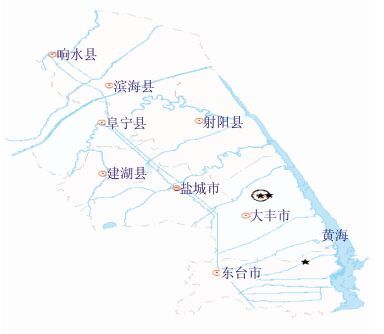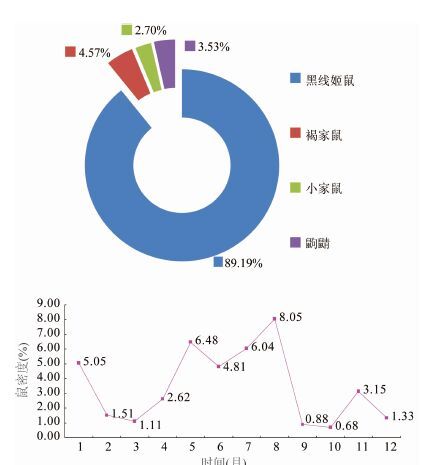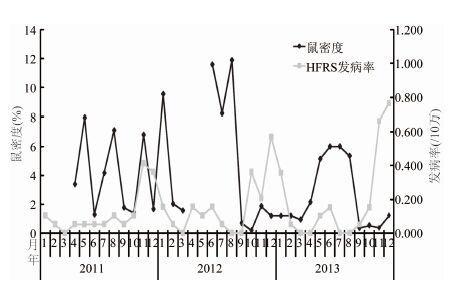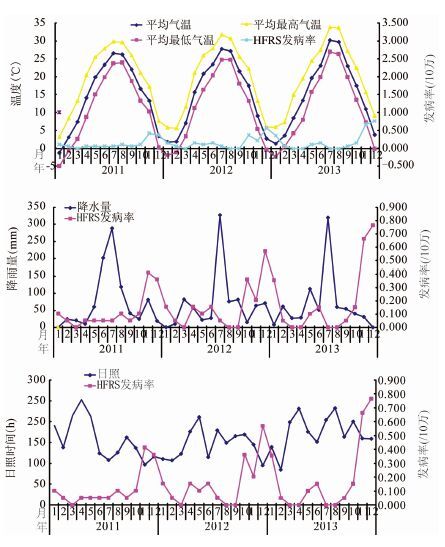扩展功能
文章信息
- 陈胤忠, 李峰, 徐慧, 黄连成, 顾振国, 孙中友, 严国进, 朱叶江, 汤池
- CHEN Yin-zhong, LI Feng, XU Hui, HUANG Lian-cheng, GU Zhen-guo, SUN Zhong-you, YAN Guo-jin, ZHU Ye-jiang, TANG Chi
- 2005-2014年江苏省盐城市沿海滩涂地区肾综合征出血热时空分布特征及影响因素研究
- Spatial temporal distribution of hemorrhagic fever with renal syndrome and related factors in coastal area of Yancheng, Jiangsu
- 疾病监测, 2016, 31(6): 477-481
- Disease Surveillance, 2016, 31(6): 477-481
- 10.3784/j.issn.1003-9961.2016.06.008
-
文章历史
- 收稿日期:2015-10-28
2. 东台市疾病预防控制中心, 江苏 东台 224200;
3. 滨海县疾病预防控制中心, 江苏 滨海 224500;
4. 大丰市疾病预防控制中心, 江苏 大丰 224100
2. Dongtai County Center for Disease Control and Prevention, Dongtai 224200, Jiangsu, China;
3. Binhai County Center for Disease Control and Prevention, Binhai 224500, Jiangsu, China;
4. Dafeng County Center for Disease Control and Prevention, Dafeng 224100, Jiangsu, China
江苏省盐城市沿海滩涂地势平坦,气候温和,雨水丰沛,日照充足,土层深厚,蕴藏着丰富特有的自然资源。沿海滩涂除有繁茂的自然植被外,还拥有140多种脊椎动物的动物资源,更有著名珍稀动物,如国家一类保护动物麋鹿、丹顶鹤等二类保护珍禽。据初步调查资料显示,还有300余种昆虫[1-4]。盐城市沿海滩涂地区除有上述滩涂、湿地外,更有规模化的粮棉与林果种植、渔业与畜牧养殖和工业与港口建设,覆盖东台市、大丰市、射阳县、滨海县和响水县的53个乡镇200万人。历史上,盐城市沿海滩涂地区曾多次发生肾综合征出血热(HFRS)暴发[5]。为掌握盐城市沿海滩涂地区HFRS的流行规律及其影响因素,为预防控制提供科学依据。对盐城市沿海滩涂地区20052014年HFRS的时空分布特征及其影响因素进行了研究,现报告如下。
1 材料与方法 1.1 HFRS时空变化分析 1.1.1 HFRS疫情数据库的建立以乡镇为单位,从中国疾病预防控制信息系统收集东台市、大丰市、射阳县、滨海县和响水县20052014年HFRS的发病数据。各年各乡镇人口数据来源于统计部门的统计年鉴,同时为每个乡镇建立唯一编号,以此作为空间分析的属性数据库。
1.1.2 地理信息数据从盐城市乡镇电子地图(1∶10 000)中提取东台市、大丰市、射阳县、滨海县和响水县相关乡镇的空间数据,并建立与属性数据库中乡镇相匹配的编码,完成空间数据库的建立。
1.1.3 统计学分析将收集的资料录入计算机,用 Excel 2003 和 SPSS 16.0 软件进行数据处理,从时间、空间两个方面对盐城市沿海滩涂地区20052014年HFRS的流行特征进行分析。利用Mapinfo 11.0 软件建立空间地理发病率数据。将空间地理发病率数据导入Satscan 9.0 软件,确定聚类最大半径为总人口的50%,蒙特卡罗模拟次数为999次,当 LLR 得 P<0.05 时,可认为扫描窗口内外相对危险度差异有统计学意义,从而进行沿海滩涂地区HFRS时空聚集性分析。
1.2 HFRS发生与影响因素相关性研究 1.2.1 鼠类种群分布与密度消长监测 1.2.1.1 监测点设置与监测生境选择按照盐城市沿海滩涂分布情况,经现场勘察,随机选择滨海县滨海港范围内的港区、镇区、二罾(振东镇),盐城市国家级丹顶鹤自然保护区,大丰市大丰港区、大丰国家级麋鹿自然保护区,东台市金东台农场笆斗高滩围垦区、三仓垦区、国华风电场和港城作为病媒生物种群分布与密度消长监测点。
1.2.1.2 监测内容和方法按照《全国病媒生物监测方案(试行)》,于2011年4月至2014年12月对盐城市沿海滩涂地区鼠类种群分布、密度、季节消长进行监测。
1.2.2 气象资料收集2011年1月至2014年12月盐城市气象资料,主要包括月平均气温、月平均最高气温、月平均最低气温、相对湿度、降雨量、降雨天数和日照时间等内容。
1.2.3 统计学分析将鼠类种群分布、密度消长监测和气象资料录入计算机,用 Excel 2003 和 SPSS 16.0 软件进行数据处理。以Pearson相关分析方法分析盐城市沿海滩涂地区HFRS时空分布、鼠种群分布与密度消长和气象指标变化的相关性。
2 结果 2.1 20052014年HFRS时空变化分析 2.1.1 时间分布HFRS 发病304例、死亡5例,总发病率为15.16/10万,10年间发病呈间歇性逐步升高,最高发病年份为2014年,发病率为2.83/10万。HFRS发病呈现冬季高峰,最高发病月份12月的发病率为4.69/10万(图 1)。
2.1.2 地区分布HFRS发病高低依次为大丰、东台、响水、射阳、滨海5个区域,平均发病率分别为4.70/10万、3.28/10万、0.51/10万、0.46/10万、0.22/10万,经统计学检验,χ2=391.15,P<0.01,沿海滩涂各区域之间HFRS发病率差异有统计学意义。发病高发地区为大丰区域的海丰农场、上海农场、川东农场和东台区域的新曹农场,发病率分别为141.58/10万、20.00/10万、19.18/10万和23.40/10万。

|
| 图 1 2005-2014年盐城市沿海滩涂地区HFRS时间分布 Figure 1 Time distribution of HFRS cases in coastal area of Yancheng,2005-2014 |
| |
将2005年1月至2014年12月HFRS发病数据和空间数据分别导入SaTScan 9.4软件分析,结果显示可能存在2个HFRS发病聚集区域(图 2):(1)2010年12月至2014年12月,东台沿海滩涂区域的新曹农场发病30例,似然比LLR=43.54,RR=11.07(P=0.000)。(2)2009年11月至2011年12月,上海农场、海丰农场发病6例,似然比LLR=14.74,RR=31.00(P=0.001)。

|
| 图 2 2005-2014年盐城市沿海滩涂地区HFRS发病回顾性空间聚集性探测结果 Figure 2 Temporal spatialclustering of HFRS cases in coastal area of Yancheng,2005-2014 |
| |
鼠类种群分布、密度消长与HFRS发病率2011-2013年盐城市沿海滩涂地区的鼠种分布有褐家鼠(Rattus norvegicus)、小家鼠(Mus musculus)、黑线姬鼠(Apodemus agrarius)和鼩鼱(Suncus murinus)。其中,黑线姬鼠为优势鼠种,构成比89.19%;褐家鼠、小家鼠和鼩鼱的构成比分别为4.57%、2.70%、3.53%。鼠密度呈现冬季与夏季两个高峰。冬季高峰为1月,鼠密度为5.05%,夏季高峰为8月,鼠密度为8.05%(图 3)。20112013年鼠类密度消长与HFRS月发病率分布见图 4,每年11月到次年1月均有1次发病高峰,每次发病高峰均有1个鼠密度高峰。

|
| 图 3 2011-2013年盐城市沿海滩涂地区鼠种群与密度消长分布 Figure 3 Rodent species and density in coastal area of Yancheng,2011-2013 |
| |

|
| 图 4 2011-2013年盐城市沿海滩涂地区鼠密度与HFRS发病率月分布 Figure 4 Rodent density and monthly incidence of HFRS in coastal area of Yancheng,2011-2013 |
| |
20112013年月平均气温、平均最高气温、平均最低气温的高峰月份均在7月,气温分别为28.13 ℃、31.73 ℃、25.13 ℃;平均相对湿度和平均日照时间的最高月份均在8月,相对湿度和日照时间分别为81.00%、169.37 h;最高平均降雨量和降雨天数均在7月,降雨量和降雨天数分别为311.67 mm和13.00 d。盐城市20112013年沿海地区气象因素与HFRS月发病率分布见图 5。HFRS发病高峰前均有1个气温、降雨量高峰,每次日照时间长发病率下降、日照时间短发病率上升,而相对湿度无上述一致性。

|
| 图 5 2011-2013年盐城市沿海滩涂地区气象因素与年出血热发病月分布结果 Figure 5 Meteorological factors and monthly incidence of HFRS in coastal area of Yancheng,2011-2013 |
| |
由Pearson相关分析可知,平均气温、平均最高气温和平均最低气温与HFRS发病率的系数分别为-0.391、-0.405、-0.379,均P<0.05,差异有统计学意义。而降雨量、降雨天数、日照时间和相对湿度及鼠密度与HFRS发病率差异无统计学意义。
3 讨论盐城市沿海滩涂广阔,滩涂面积分别占全国、全省的15.00%和70.00%,而且每年仍以50 000亩的成陆速度向东延伸。在沿海滩涂开发过程中对生态环境的影响,尤其是生态环境对人类健康的影响显得十分重要[6]。对20052014年盐城市沿海滩涂地区HFRS流行特征分析表明,HFRS发病呈间歇性逐步升高,最高发病年份为2014年,并呈现冬季高峰;高发地区以大丰、东台区域为主。上述特点与以往文献报道沿海地区HFRS流行特征一致[7-9]。HFRS高发乡镇为大丰区域的海丰农场、上海农场、川东农场和东台区域的新曹农场,表明上述地区存在HFRS的流行因素。
近年来,利用地理信息系统(GIS)分析传染病的时空分布,预测传染病的发生发展,并已得到很好的应用[10-11]。本研究采用时空聚集性分析方法对HFRS分析[12-13],20052014年盐城沿海滩涂地区HFRS可能存在两个发病聚集区域,分别为2010年12月至2014年12月东台区域的新曹农场和2009年11月至2011年12月大丰区域的上海农场、海丰农场,提示在发病聚集区域内存在HFRS的流行因素,可能包括特有的滩涂湿地、鼠及其螨等寄生虫。
盐城市沿海滩涂地区的鼠种分布主要有褐家鼠、小家鼠、黑线姬鼠,其中,黑线姬鼠为优势鼠种。该结果与江苏省沿海地区HFRS的宿主动物分布一致[14-16]。20112013年鼠密度呈现冬季与夏季两个高峰,冬季高峰在1月,鼠密度为5.05%;夏季高峰为8月,鼠密度为8.05%,该结果与以往文献报道不同[17],说明盐城市沿海滩涂地区鼠类生存环境与生物学特点可能有别于其他地区,有待今后进一步研究。
本研究首次通过对盐城市沿海滩涂地区鼠类密度消长、气象参数与HFRS发病的相互关系分析发现,20112013年HFRS每年发病高峰与鼠密度高峰具有一致性,也与气温、降雨量高峰密切相关。由Pearson相关分析可知,平均气温、平均最高气温和平均最低气温与HFRS发病率具有统计学相关性,而降雨量、日照时间和鼠密度与HFRS发病率无统计学相关性。以往未见类似报道,仅见气象因素对其他虫媒传染病的影响研究[12-13, 18]和HFRS的发生与鼠密度的消长相关性研究的文献报道[19],本次研究仅发现气温与HFRS发病率具有统计学相关性,但相对湿度、降雨量、日照时间等气象因素均影响鼠及其寄生虫的生长繁殖,因此,今后还需要进一步深入研究。
| [1] | Wang LP, Geng RQ, Liu ZQ, et al. Current status analysis of invasive pest insects and pathogens in Jiangsu coastland[J]. Journal of Anhui Agricultural Sciences, 2008, 36 (31) : 13748.(in Chinese) 王兰萍, 耿荣庆, 刘忠权, 等. 江苏沿海地区入侵害虫和病原生物的现状分析[J]. 安徽农业科学,2008,36 (31) :13748. |
| [2] | Liu WY, Yang SB, Tang J, et al. Analysis of population and density of vector at 2010-2011 in Funing county[J]. Jiangsu Journal of Preventive Medicine, 2013, 24 (3) : 43–44 .(in Chinese) 刘文羽, 杨尚波, 唐杰, 等. 阜宁县2010-2011年按蚊种群及密度监测分析[J]. 江苏预防医学,2013,24 (3) :43–44. |
| [3] | Zhu HB. Monitored on thedensity of vector at 2013 in Yandu District of Yancheng city area[J]. Jiangsu Health Care, 2014, 16 (2) : 31–32 .(in Chinese) 朱海波. 盐城市盐都区2013年病媒生物密度监测[J]. 江苏卫生保健,2014,16 (2) :31–32. |
| [4] | Wu ZM, Zhu HM, Chang TX, et al. Investigation of mosquito abundance and composition around the rare birds national nature reserve of Yancheng, Jiangsu province[J]. Chinese Journal of Parasitology and Parasitic Diseases, 2007, 25 (4) : 310–313 .(in Chinese) 吴争鸣, 朱淮民, 常唐喜, 等. 盐城国家级珍禽自然保护区蚊虫密度调查与分析[J]. 中国寄生虫学与寄生虫病杂志,2007,25 (4) :310–313. |
| [5] | Wang FQ, Liu GL, Shao RB, et al. An outbreak of EHF occurred in the project of developing tidal-land[J]. Chinese Journal of Vector Biology and Control, 1991, 2 (6) : 391–393 .(in Chinese) 王福泉, 刘光连, 邵荣标, 等. 一起滩涂开发工地流行性出血热暴发的调查分析[J]. 中国媒介生物学及控制杂志,1991,2 (6) :391–393. |
| [6] | 陈宏观.沿海地区生态环境评价及生态建设研究[D].南京:南京林业大学,2012:28-66. Chen HG. Study on the evaluation of ecological environment and ecological construction incoastal areas[D]. Nanjing:Nanjing Forestry University ,2012:28-66. (in Chinese) |
| [7] | Deng XZ, Zhang Y, Wang ZC, et al. Geographic characteristics and prevalence of hemorrhagic fever with renal syndrome in sotheast coastal area of China[J]. Chinese Journal of Public Health, 2010, 26 (2) : 176–177 .(in Chinese) 邓小昭, 张云, 王忠灿, 等. 东南沿海地区地理景观与HFRS流行特征关系[J]. 中国公共卫生,2010,26 (2) :176–177. |
| [8] | Zu RQ, Wu YS, Zhu FC, et al. Surveillance on hemorrhagic fever with renal syndrome in Jiangsu province from 1996 to 2000[J]. Chinese Journal of Epidemiology, 2003, 24 (2) : 109–113 .(in Chinese) 祖荣强, 吴扬生, 朱凤才, 等. 江苏省1996-2000年肾综合征出血热监测分析[J]. 中华流行病学杂志,2003,24 (2) :109–113. |
| [9] | Lin XD, Guo WP, Wang W, et al. Prevalence of Hantavirus infections in humans and animals in Wenzhou city[J]. Chinese Journal of Vector Biology and Control, 2010, 21 (3) : 235–237 .(in Chinese) 林献丹, 郭文平, 王文, 等. 汉坦病毒在温州市人与动物间的流行情况[J]. 中国媒介生物学及控制杂志,2010,21 (3) :235–237. |
| [10] | Vieira V, Webster T, Aschengrau A, et al. A method for spatial analysis of risk in a population-based case-control study[J]. Int J Hyg Environ Health, 2002, 205 (1/2) : 115–120 . |
| [11] | Kitsiou D, Karydis M. Categorical mapping of marine eutrophication based on ecological indices[J]. Sci Total Environ, 2000, 255 (1/3) : 113–127 . |
| [12] | 李亚楠.我国疟疾流行时空分布特征及淮河流域疟疾环境影响因素研究[D].北京:中国人民解放军军事医学科学院,2013:40-50. Li YN. Study on the Spatio-temporal distribution characteristics of malaria prevalency in China and the environmental factors on malaria in the Huaihe River Basin[D]. Beijing:Academy of Military Medical Sciences ,2013:40-50. (in Chinese) |
| [13] | 余向华.蚊媒传染病流行特征及气象影响因素研究[D].杭州:浙江大学,2007:17-27. Yu XH. Study on the epidemic characteristics of mosquito-borne diseases and their association with climate factors[D]. Hangzhou:Zhejiang University ,2007:17-27. (in Chinese) |
| [14] | Liu GZ, Zhu FC, Wu YS, et al. Review and perspective of epidemic hemorrhagic fever in the Past 20 years in Jiangsu province[J]. Jiangsu Journal of Preventive Medicine, 2002, 13 (1) : 80–83 .(in Chinese) 刘光中, 朱凤才, 吴扬生, 等. 江苏省流行性出血热防治研究20年回顾与展望[J]. 江苏预防医学,2002,13 (1) :80–83. |
| [15] | Zu RQ, Wu YS, Zhu FC, et al. Surveillance of hemorrhagic fever with renal syndrome and studies on its predictive indices in Jiangsu province[J]. Chinese Journal of Epidemiology, 1999, 20 (4) : 220–223 .(in Chinese) 祖荣强, 吴扬生, 朱凤才, 等. 江苏省肾综合征出血热监测与疫情预测指标研究[J]. 中华流行病学杂志,1999,20 (4) :220–223. |
| [16] | Zhang YZ, Dong X, Li X, et al. Seoul virus and hantavirus disease, Shenyang, People's Republic of China[J]. Emerg Infect Dis, 2009, 15 (2) : 200–206 . |
| [17] | Yang WF, Xu Y, Chu HL, et al. Population dynamic analysis of main vectors from 2002 to 2007 in Jiangsu province[J]. Chinese Journal of Vector Biology and Control, 2008, 19 (5) : 432–435 .(in Chinese) 杨维芳, 徐燕, 褚宏亮, 等. 2002-2007年江苏省主要病媒生物密度与构成情况分析[J]. 中国媒介生物学及控制杂志,2008,19 (5) :432–435. |
| [18] | 王成岗.广东省登革流行特征及气象因素对广州市登革的影响研究[D].济南:山东大学,2014:44-65. Wang CG. A study on the epidemiological characteristics of dengue in Guangdong province and the impact of meteorological factors in Guangzhou[D]. Ji'nan:Shandong University, 2014:44-65. (in Chinese) |
| [19] | Qin CM, Liu Y, Yao WQ, et al. Study on the surveillance of hemorrhagic fever with renal syndrome in national surveillance sites in Liaoning[J]. Disease Surveillance, 2007, 22 (3) : 162–164 .(in Chinese) 秦彩明, 刘芸, 姚文清, 等. 辽宁省国家监测点肾综合征出血热监测分析[J]. 疾病监测,2007,22 (3) :162–164. |
 2016, Vol. 31
2016, Vol. 31


